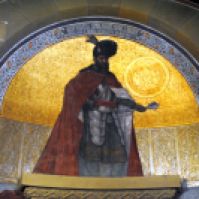Have you ever been to a restored historical place and got the feeling that you are actually entering a time-warp that takes you back to when the place (be it a citadel, a church, a castle or whatever historical building) was built? That’s what happened to me when I set foot in the excellent-looking recently rehabilitated Alba Carolina Citadel in Alba Iulia, Romania.
Short history of the city
5th millennium BC – prehistoric settlement.
106 BC – Roman castra (Colonia Aurelia Apulensis and Colonia Nova Apulensis) on the spot of an older Dacian settlement (Apoulon).
1542-1690 – capital of Transylvania.
1599 – the first political union of Transylvania, Moldavia and Wallachia under Michael the Brave took place here.
1918 – proclamation of the union of Transylvania with Romania.
1922- coronation of King Ferdinand and Queen Marie.
Short history of the citadel
On the spot of the current citadel have been found traces indicating the existence of two other fortifications: the Roman Castrum of Legio XIII Gemina (106 BC) and Bălgrad Medieval Citadel (16th-17th centuries).
Towards the end of the 17th century, the Habsburgs liberated Transylvania from Ottoman rule and started a project of defending its new provinces by means of a network of fortifications. The plans of the citadel, based on the style of fortifications designed by the French Marquis de Vauban during the reign of Louis XIV, were approved by Prince Eugene of Savoy himself. They included 4 systems of defence, but only 3 were actually built. The building of the citadel lasted for 23 years (between 1715 and 1738), and minor changes were made continuously along the years, until 1873.
The main structure of the citadel has the form of an irregular heptagon (7 sides) with 7 bastions, which gave it a star-shaped aspect. It had 7 triumphal gates which ensured access inside the citadel, all decorated with Baroque statues.
What to visit inside the citadel
Coronation Cathedral – the Romanian Orthodox church dedicated to the Holy Trinity and the Holy Archangels Michael and Gabriel where King Ferdinand and Queen Marie were coronated in 1922. It’s a great example of Romanian architecture (Brancovenesc style). Inside you can find excellent frescoes and portraits of Michael the Brave, King Ferdinand and Queen Marie.
National Museum of the Union – history gallery exhibiting archaeological artifacts, coins, books belonging to the Roman, medieval and modern history of the region.
Union Hall – the building where the Great National Assembly voted the Union of Transylvania with Romania in 1918.
Batthyaneum Library – impressive collection of rare books, including Codex Aureus of Lorsch, a Gospel book dating from the 8th century, written in gold letters.
Roman-Catholic Cathedral – considered to be one of the oldest cathedrals in Romanesque style in the country. Inside you can find various tombs, including that of John Hunyadi (Ro: Iancu de Hunedoara), famous voivode of Transylvania.
Cell of Horea, Closca and Crisan – the cell where were imprisoned the leaders of the 1784 revolt against serfdom.
If you visit Alba Iulia, take a tour of the walls and gates of Alba Carolina citadel. It’s stylish and it looks as if time had not passed over its walls. You will be welcomed by many bronze statues and living Habsburg soldiers ready to take a picture with you. Moreover, at 12:00 sharp you can take part in the ceremony of the Changing of the Guard (at the 3rd and 4th gates), which includes soldiers, horses, flags, swords and drums. Don’t forget to pay a visit to the lovely horses from the Headquarters of the Cavalry Corps!

















Pingback: Happy National Day, Romania and Romanians! | Dana's Boots